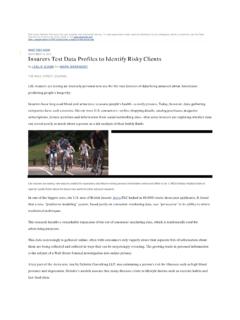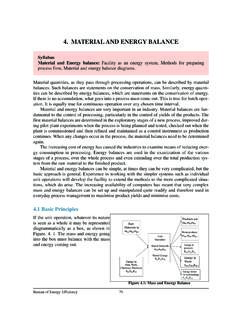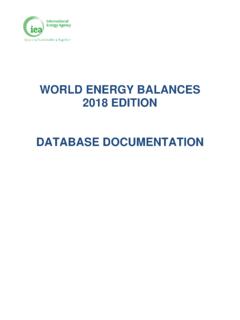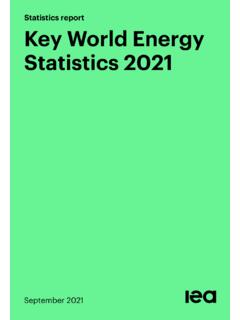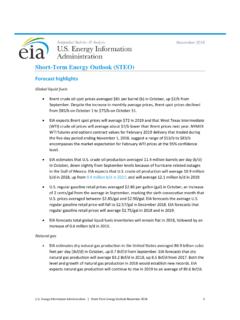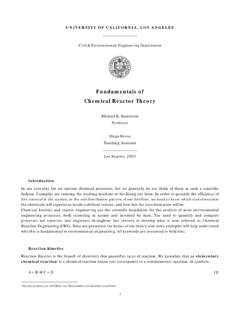Transcription of Chapter 8 and 9 – Energy Balances
1 CBE2124, Levicky 1 Chapter 8 and 9 Energy Balances Reference States. Recall that enthalpy and internal Energy are always defined relative to a reference state ( Chapter 7). When solving Energy balance problems, it is therefore necessary to define a reference state for each chemical species in the Energy balance (the reference state may be predefined if a tabulated set of data is used such as the steam tables). Example. Suppose water vapor at 300 oC and 5 bar is chosen as a reference state at which H is defined to be zero. Relative to this state, what is the specific enthalpy of liquid water at 75 oC and 1 bar? What is the specific internal Energy of liquid water at 75 oC and 1 bar? (Use Table B. 7). Calculating changes in enthalpy and internal Energy . H and U are state functions, meaning that their values only depend on the state of the system, and not on the path taken to arrive at that state. IMPORTANT: Given a state A (as characterized by a set of variables such as pressure, temperature, composition) and a state B, the change in enthalpy of the system as it passes from A to B can be calculated along any path that leads from A to B, whether or not the path is the one actually followed.
2 Example. 18 g of liquid water freezes to 18 g of ice while the temperature is held constant at 0 oC and the pressure is held constant at 1 atm. The enthalpy change for the process is measured to be H = - kJ. What would the H for the process be if, instead, the 18 g of water is first heated from 0 oC to 100 oC and entirely vaporized to steam at 100 oC and 1 atm, then liquified by compression from 1 atm to 10 atm at 100 oC, than cooled to - 200 oC CBE2124, Levicky 2(during which step it freezes to ice) while being decompressed to a pressure of 1 atm, and finally thus formed 18 g of ice is heated from -200 oC and 1 atm to ice at 0 oC and 1 atm? Types of Paths. There are five types of paths for which we will learn to calculate enthalpy changes H : 1). Changes in pressure (p) at constant temperature (T) and state of aggregation ( no phase changes). 2). Changes in T at constant p and state of aggregation. 3). Phase changes ( melting, condensation, evaporation, solidification, sublimation) at constant T and p.
3 4). Mixing steps (two liquids, gas in a liquid, solid in a liquid) at constant T and p. 5). Chemical reactions taking place at constant T and p. The overall path from a state A to a state B will be able to be expressed as a combination of the above five types of steps. Because enthalpy is a state function, the total change H for passing from state A to state B can be calculated as the sum of the enthalpy changes H j for the individual steps, H = H 1 + H 2 + H 3 + H j = 1, 2, ..k (1) where k is the total number of steps used, for purposes of the calculation, to take the system from the initial state A to the final state B. Note that the steps used for the calculation do not need to correspond to the actual path taken by the system from A to B. Example. Construct a process path, consisting of the types of steps listed above, that could be used to calculate the enthalpy change for the following processes.
4 (i) Cyclohexane vapor at 180 oC and 5 atm is cooled and condensed to liquid cyclohexane at 25 oC and 5 atm. The enthalpy change for the condensation of cyclohexane at oC and 1 atm is known. CBE2124, Levicky 3 (ii) O2 at 170 oC and 1 atm and CH4 at 25 oC and 1 atm are mixed and react completely to form CO2 and H2O at 300 oC and 1 atm. The enthalpy change for the reaction occurring at 25 oC and 1 atm is known. Paths of type 1 changes in pressure (p) at constant temperature (T) and state of aggregation Liquids and solids: U and V are only weak functions of p for liquids and solids. Thus, for a path of type 1 performed on a system that is a liquid or a solid, U 0 and V 0. This in turn implies that H = U + (pV ) V p (solids or liquids, change in p only) (2) Gases: for gases that can be modeled as ideal, internal Energy and enthalpy only depend on T. Thus, for a type 1 path, for an ideal gas U and H are both zero since T is not changing.
5 Note that H = U + pV = U + RT/M for an ideal gas, where M is the mass of 1 mole of the gas. This expression assumed that specific quantities are expressed per unit mass of substance. If specific quantities are expressed per mole of substance, then, for an ideal gas, H = U + pV = U + RT. For gases behaving non-ideally, either tables of U and H ( like the steam tables) CBE2124, Levicky 4must be used or more complex calculations (not covered in this course) are required. Example. Given the process C2H6 (g, 25 oC, 1 atm) C2H6 (g, 25 oC, 30 atm) How would you use the compressibility charts to determine whether it is reasonable to assume H = 0? Paths of type 2 changes in T at constant p and state of aggregation Sensible heat: Sensible heat is heat added to a system that results in a change in temperature (as opposed to latent heat, see below). Internal Energy changes. The rate of change of specific internal Energy of a substance with T, while its volume V is kept fixed ( no PV work), is called the heat capacity at constant volume and is given the symbol CV, VVTUTC = )( (3) Note that CV is in general a function of T.
6 Given the function CV(T), the change in specific internal Energy as the system temperature is raised from T1 to T2 at constant volume is = 21)( TTVdTTCU (constant V) (4) However, a type 2 path is in general not a constant volume process. Rather, as T changes, in order to maintain V strictly constant one would have to adjust p as well, CBE2124, Levicky 5violating the requirement p = constant for a type 2 path. How can we resolve this difficulty? Fortunately, the volume of liquids and solids in general does not change very much with T. Therefore, it is usually a very good approximation to assume that, for a type 2 path, one can still use 21)( TTVdTTCU (solids and liquids, type 2 path) (5) Moreover, for ideal gases, since U is a function of temperature only, equation (4) is exact even though the volume will change for a type 2 path, = 21)( TTVdTTCU (ideal gases, type 2 path) (4) For gases behaving nonideally, equation (4) is exact only if V is maintained constant during the temperature change, what in general will not be true for a type 2 path.
7 Since V will in general change during the performance of a type 2 path with a nonideal gas, one has to resort to more complex calculations (not covered in this course) or use tabulated information ( steam tables). Enthalpy changes. The rate of change of specific enthalpy H of a substance with T, while the pressure p on the substance is kept fixed (a type 2 process), is called the heat capacity at constant pressure and is given the symbol Cp, ppTHTC = )( (6) Cp is in general a function of T. Given the function Cp(T), the change in enthalpy of a substance as its temperature is raised from T1 to T2 at constant pressure is = 21)( TTpdTTCH (type 2 process) (7) CBE2124, Levicky 6 Evaluation of heat capacities (also known as "specific heats"). Cp and CV have units of Energy per amount per temperature interval, where the amount of material may be measured in molar or mass units ( units of heat capacity could be J/(kg oC), J/(mol oC), etc). Table provides polynomial expressions for heat capacities Cp Cp = a + bT + cT2 + dT3 (8) where a, b, c and d are constants.
8 Most often we will use these expressions. NOTE: in some cases Cp may be available at equally spaced T intervals ( from a table), rather than in the form of equation 8. In those instances, equation 7 can be numerically integrated with respect to T to obtain H , for example using Simpson's Rule (see Appendix ). Kopp's Rule. Kopp's rule is used to roughly estimate Cp values for materials based on their atomic composition. See text for discussion. Cp values for mixtures. When dealing with heat capacities of mixtures, the most accurate method is to look up Cp values from tables or other experimental information, if available. Lacking such data, if one is willing to neglect corrections to Cp that derive from mixing of the different components of the mixture, the overall heat capacity of the mixture Cp,mix can be approximated as the sum of heat capacity contributions from the separate components of the mixture, Cp,mix(T) = componentsmixtureallipiTCx)(, (9) In equation 9, the index i ranges over all of the components of the mixture.
9 Xi is the mass fraction (if using heat capacities expressed per mass of material) or mole fraction (if using heat capacities expressed per mole of material) of component i in the mixture, and Cp,i is the heat capacity of species i in its pure form. The enthalpy change H for a type 2 path performed on a mixture is then calculated by inserting the expression for Cp,mix from equation 9 into equation 7. Example. For ideal gases, Cp = CV + R. How can one prove this expression? CBE2124, Levicky 7 Example. For liquids and solids, Cp CV. How can we justify this approximation? Example Assuming ideal gas behavior, calculate the heat transferred in the following situations: 1). A stream of nitrogen flowing at 100 mol/min is heated from 20 oC to 100 oC. 2). Nitrogen in a 5 L flask, at an initial pressure of 3 bar, is cooled from 90 oC to 30 oC. For nitrogen at a constant pressure of 1 atm, the heat capacity Cp is Cp(kJ/(mol oC)) = + 10-5T + 10-8T2 - 10-12T3 CBE2124, Levicky 8 CBE2124, Levicky 9 CBE2124, Levicky 10 Example A stream containing 10 % CH4 and 90 % air by volume is to be heated from 20 oC to 300 oC.
10 Calculate the required rate of heat input in kilowatts if the flow rate of the gas is 103 liters (STP)/min. Assume ideal gas behavior. Table provides specific enthalpy of air, yielding H air,in = kJ/mol and H air,out = kJ/mol. The heat capacity of methane is given by Cp (kJ/(mol oC)) = + 10-5T + 10-8T2 - 10-12T3 Also, in solving this problem, do you think we can neglect the enthalpy of mixing of methane and air? Why yes or why not? CBE2124, Levicky 11 CBE2124, Levicky 12 Example A gas stream containing mole % CO and mole% CO2 at 500 oC is fed to a waste heat boiler. In the boiler, heat is transferred from this gas stream to a water stream, which is fed to the boiler at 25 oC in a ratio of mole feed water per mole of hot gas. The water is heated by the gas so that it forms saturated steam at bar. The boiler operates adiabatically, with all heat lost by the gas stream going to heat the water stream.







